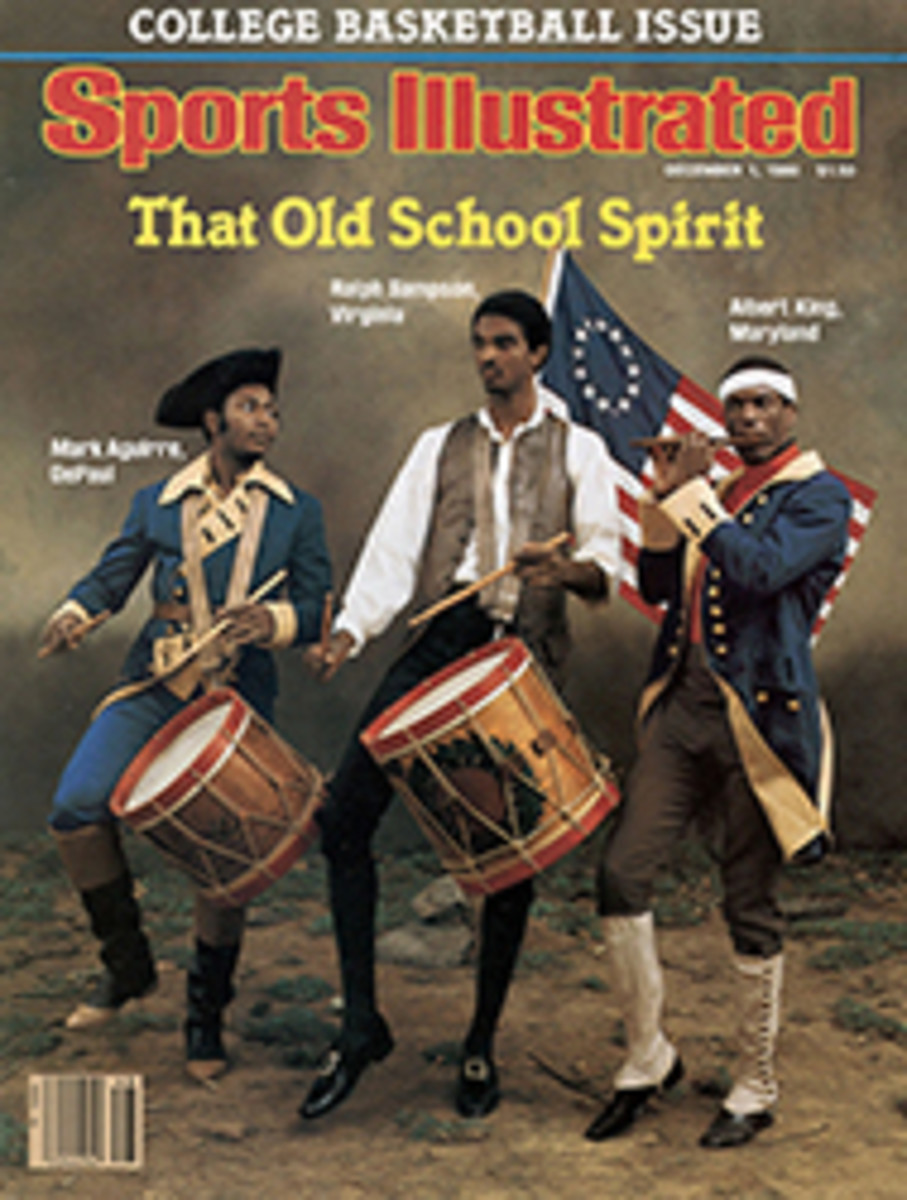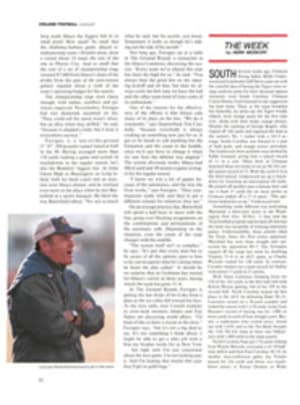
THOSE HEISMAN HIGH-FLYERS
College football's most famous running back is 13½ inches tall and weighs 25 pounds. He's hard to bring down because he has a pretty mean stiff-arm and is made of solid bronze. He is, of course, the Heisman Trophy, which goes each season to the man voted the game's outstanding player. Heisman time is here again, and for the past two weeks ballots from 1,050 writers and broadcasters, many of whom know something about football, have been arriving at the offices of Harris, Kerr, Forster & Co., certified public accountants, in New York City.
Shortly after noon on Monday, Dec. 1 the final tally will be hand-carried to the Downtown Athletic Club, which founded the award in 1935 and has sponsored it ever since. Minutes later, Carmine Ragucci, the DAC's Heisman chairman, will pick up his telephone and call—well, no one can be sure just whom. Here are the leading candidates:
•George Rogers, South Carolina. Not playing in a major conference could hurt. Most winners have come from the likes of the Pac-10 and Big Eight, or from among notable independents like Notre Dame, Penn State and Pitt. South Carolina lacks a great football heritage. Also, no southern black has ever won, largely because, until about 1965, blacks weren't recruited by the major football schools in the South.
Rogers began to stake his Heisman claim last season, when he rushed for 1,681 yards—second only to USC's Charles White. South Carolina won eight games, the most in its history. This season the Fighting Gamecocks once again have eight victories. Credit Rogers, a one-man offense. Although South Carolina was upset 27-6 by Clemson last Saturday, Rogers banged out 168 yards in 28 carries, his 21st consecutive 100-yard game. He has gained 1,781 yards this season and is the leading runner in the country. So were the last four Heisman winners.
Rogers was a long shot in the preseason Heisman sweepstakes. His talents had never been showcased on national television, nor were they scheduled to be, and getting on the tube is a must. All winners since 1967 have played in at least one nationally televised game. And though Rogers was second to White in rushing, in the Heisman voting he was seventh—behind Ohio State's glamour quarterback, Art Schlichter and just ahead of Purdue's Mark Herrmann, both back this fall. Because South Carolina faced such powerhouses as Georgia, USC and Michigan, it trumpeted that fact to emphasize that Rogers wasn't getting his yards against patsies. But because the schedule also included Pacific, Wichita State, Cincinnati and The Citadel, the rugged-opponent argument didn't wash.
Rogers promoted himself by gaining more yards against USC (141) and Michigan (142) than he did against Cincinnati (128) and Wichita State (108). And when the Georgia game was shown on national TV, Rogers ran for 168 yards. The trouble was, Bulldog freshman Herschel Walker had more (219), including a glittering 76-yard touchdown run, and Georgia won. What might damage Rogers more was his fourth-quarter fumble on the Georgia 16. But remember, two years ago Oklahoma's Billy Sims made a similar fumble that cost the Sooners a possible national title and gave Nebraska a tie for the Big Eight championship. And he still won the Heisman. Rogers should do so, too.
•Herschel Walker, Georgia. One intangible going for Walker is his name. Consider these past winners: Nile Kinnick, Angelo Bertelli, O.J. Simpson, Archie Griffin and—yes—Doak Walker. A Jim Walker gets no easy votes. A Herschel Walker might.
But Walker has credentials, too. He is fourth in the nation in rushing with 1,411 yards through 10 games. If he hits his average (141.1) this week against Georgia Tech, he'll have 1,552—second only to Tony Dorsett among freshmen runners. Project Walker's average over a 44-game career and it comes to 6,208—surpassing Dorsett's record 6,082.
Walker is 6'2" tall, weighs 220 pounds and has 4.3 speed. Without him last year, Georgia had a 6-5 record. With him, practically the same Bulldog team is 10-0 and ranked No. 1. Besides the televised game against South Carolina, Walker was on the next week against Florida, when he ran 72 yards for a touchdown. The two TV appearances came at what might be called Heisman prime time, the first two weeks in November, a definite plus.
If the Bulldogs beat Tech—and they will be heavy favorites to do so—they will need only one more victory, over Notre Dame in the Sugar Bowl, to nail down the national championship. Nineteen of the 45 Heisman winners played either on undefeated teams or teams that won some kind of mythical national championship.
Now for a definite minus. Only six juniors—Doc Blanchard in 1945, Doak Walker in 1948, Vic Janowicz in 1950, Roger Staubach in 1963, Griffin in 1974 and Sims in 1978—have won the trophy. No sophomore has ever won. Nor has a freshman. In fact, not one has ever been among the top 10 vote-getters. Despite having seen Walker sparkle, many voters still think a player must prove himself in more than one season. Bet on Walker to finish second.
•Hugh Green, Pittsburgh. The 6'2", 222-pound senior defensive end-linebacker is a two-time consensus All-America, certain to be a three-timer, and is easily the best defender on the nation's best defense. But when it comes to glory, defense always comes in second. After the season Pitt will retire Green's number, but how many people outside Pittsburgh know what that number is?
In four seasons Green has made 269 solo tackles and helped out on another 177. He has nailed quarterbacks 53 times—for a total of—374 yards. He's done it despite incessant double- and triple-teaming and an inordinate number of plays that go the other way. Largely because of Green, Pitt is 9-1 and ranked in the Top 10 for the third year in Green's four seasons.
He has an obvious zest for his job. "On defense, all we want to do is hit, get up and then hit harder the next time," he says. "Offense is more for the witty and brainy types. Me, if I don't crush somebody on a play, I'm disappointed." To alert voters to Green, Pitt sports information director Dean Billick recently mailed to writers and broadcasters across the land some 2,500 2' by 3' four-color posters of Green with capsule raves from the critics. But such Academy Award-type tactics may alienate more voters than they persuade. And no strictly defensive lineman has ever won a Heisman, although a pair of two-way players have—Yale End Larry Kelley in 1936 and Notre Dame End Leon Hart in 1949. Look for Green to finish third.
•Art Schlichter, Ohio State. The preseason Heisman favorite, Schlichter was fourth as a sophomore in last year's voting and this fall seemed to have a lock. Good team, good position, good looks. A passing cover boy. He started fast, as did the Buckeyes, but then came a televised encounter with UCLA the first weekend of October, a battle of unbeatens. UCLA won and Schlichter was shut out, 17-0. He was intercepted, sacked a half-dozen times and completed only five of 12 passes for 59 yards—his worst performance ever. He looked equally inept last week as Ohio State lost to Michigan 9-3, but it really didn't matter. He was already a loser.
•Mark Herrmann, Purdue. The 6'5", 194-pound senior quarterback's claim is his four-year record. As a freshman he passed for 2,453 yards, the next year he threw for 1,904 and last year it was 2,377. Herrmann has added another 2,923 yards this season, increasing his career total to 9,657 yards. He has broken the NCAA major college record of 7,818 yards set by Jack Thompson of Washington State in 1975-78. But Herrmann's 17 interceptions this season brought his career total to 75, which also broke an NCAA record. Like Schlichter, Herrmann was done in on TV. Purdue had two national appearances. In its first, against Notre Dame, Herrmann was sidelined with a sprained thumb. As it turned out, he was better off in that game than in the second. That came two weeks ago against Michigan, and Herrmann completed 21 of 34 passes, but for only 129 yards while being intercepted four times in a 26-0 Boilermaker defeat.
•Neil Lomax, Portland State. As far as voters are concerned, there may be no Neil Lomax, only some enterprising young sports information director who mails in stats each week that seem to read like this: 85 passes, 71 completions for 15 touchdowns and 984 yards. State wins it 176-3. But who has seen him in action? Also, many voters may not realize that although the Vikings are a Division I-AA team, its players are eligible for the Heisman. Consequently Lomax, who probably will be the No. 1 pro draft pick, has no more chance than did a blond quarterback from Louisiana Tech in 1969; name of Terry Bradshaw.
•Freeman McNeil and Ken Easley, UCLA. When a team is pushing two Heisman candidates, it's like the coach who says he has four equal quarterbacks; it means he has none. Despite injuries that have kept him out of two full games, McNeil has gained 100 yards or more in each of the seven games he has played this season—and has had 25 100-yard afternoons in a row. Easley is the best free safety in the country. Both looked good on television this season. But in this case one plus one equals zero. To make it tougher, USC Tailback Marcus Allen will draw some West Coast votes.
•Jim McMahon, Brigham Young. The junior quarterback has gargantuan passing stats, but this season so many quarterbacks are completing so many passes for so many yards and so many touchdowns, they tend to cancel each other. Scratch McMahon. Ditto Stanford's John Elway and Illinois' Dave Wilson.
Those are the leading contenders. And here's one more number of interest, especially for Carmine Ragucci of the DAC. It's 803. That's the area code for Columbia, S.C.
PHOTO
GEORGE ROGERS, SOUTH CAROLINA
PHOTO
MARK HERRMANN, PURDUE
PHOTO
HERSCHEL WALKER, GEORGIA
PHOTO
HUGH GREEN, PITTSBURGH
PHOTO
NEIL LOMAX, PORTLAND STATE
PHOTO

